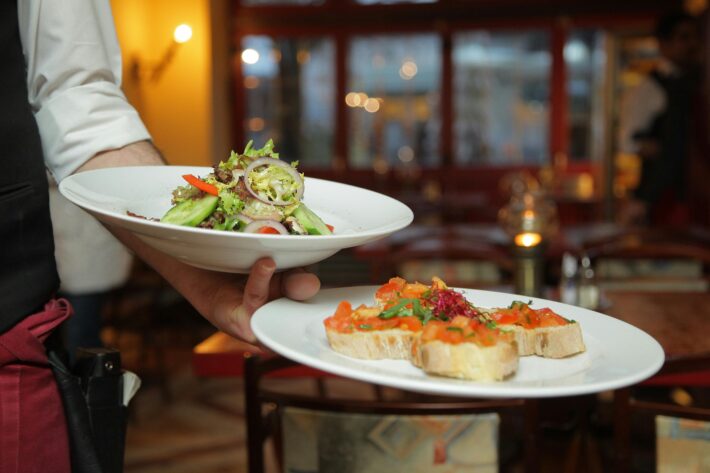Automating Menu Personalization with AI in F&B

Introduction
In an era where technology is rapidly evolving, the Food and Beverage (F&B) industry is undergoing a significant transformation. With the integration of AI & Automation, businesses are not only streamlining their operations but also enhancing customer experiences. The significance of automating menu personalization cannot be overstated, especially as consumers increasingly demand tailored experiences. Consider Starbucks, which utilizes AI to analyze customer data for personalized drink recommendations. By understanding individual preferences and behaviors, Starbucks not only boosts customer satisfaction but also drives sales, showcasing the potential of AI & Automation in the F&B sector.
As the competition intensifies, restaurants and food businesses must leverage AI & Automation to remain relevant and appealing to tech-savvy consumers. From predicting trends to optimizing supply chains, AI is reshaping the landscape. This blog will delve into key strategies and best practices for effectively implementing AI & Automation in menu personalization, emphasizing real-world examples and actionable insights.
Key Strategies for AI & Automation
1. Predictive Analytics for Menu Personalization
Predictive analytics is a powerful tool that utilizes AI & Automation to forecast customer preferences and behaviors. By analyzing past data, businesses can anticipate what menu items will resonate with their customers. This not only enhances customer satisfaction but also minimizes food waste, as restaurants can better align their inventory with consumer demand.
#### Why Predictive Analytics Matters
- Customer Satisfaction: By offering personalized menu items based on customer preferences, businesses can significantly improve the dining experience.
- Operational Efficiency: Reducing food waste saves costs and enhances profit margins.
- Competitive Advantage: Utilizing predictive analytics can set a business apart from competitors who are slower to adopt technology.
#### Implementation Steps
1. Data Collection: Gather data from various sources, including point-of-sale systems, customer feedback, and social media interactions.
2. Data Analysis: Use AI algorithms to analyze the data and identify trends and patterns in customer preferences.
3. Menu Optimization: Adjust menu offerings based on the insights gained from the data analysis.
Example: Domino’s Pizza employs predictive analytics to optimize their menu. By analyzing customer orders and preferences, they can suggest personalized pizza combinations that are likely to please individual customers. This has not only improved customer satisfaction but also increased sales significantly.
Key Takeaways:
- Enhance customer experience through personalized recommendations.
- Utilize data-driven insights to minimize waste and optimize inventory.
- Stay ahead of competitors by adopting AI-driven analytics tools.
For further reading on predictive analytics, check out this insightful article from Harvard Business Review: Predictive Analytics in the Age of COVID-19.
2. Chatbots for Customer Interaction
The integration of chatbots in the F&B industry represents another powerful application of AI & Automation. These AI-driven systems can engage with customers in real-time, providing personalized recommendations and handling inquiries efficiently.
#### Why Chatbots Matter
- 24/7 Availability: Chatbots can interact with customers at any time, providing instant responses to inquiries and facilitating orders.
- Cost Efficiency: Reducing the need for a large customer service team can significantly lower operational costs.
- Data Collection: Chatbots can gather data on customer inquiries and preferences, offering valuable insights for future menu personalization.
#### Implementation Steps
1. Define Objectives: Determine what tasks the chatbot will handle, such as answering FAQs, taking orders, or providing menu recommendations.
2. Choose a Platform: Select a chatbot-building platform that integrates well with existing systems.
3. Train the Bot: Use historical data to train the chatbot on common customer queries and menu items.
Example: Pizza Hut has successfully implemented a chatbot on Facebook Messenger that allows customers to place orders directly through the platform. This convenience has led to increased engagement and sales.
Key Takeaways:
- Automate customer interaction to enhance service delivery.
- Capture valuable customer data for future personalization efforts.
- Improve overall efficiency by minimizing manual workloads.
For more on the effectiveness of chatbots in customer service, explore this comprehensive guide from Chatbots Magazine: How Chatbots are Revolutionizing Customer Service.
Best Practices for AI & Automation
Key Actionable Tips
1. Invest in High-Quality Data: The efficacy of AI & Automation hinges on the quality of the data used. Ensure data collection methods are robust and cover various customer touchpoints.
– Example: A restaurant that collects data from online reservations, social media interactions, and in-store feedback will have a comprehensive view of customer preferences.
2. Continual Learning: AI systems should be designed to learn over time. Regularly update algorithms based on new data to ensure accuracy in menu personalization.
– Statistic: According to a study by McKinsey, businesses that leverage AI & Automation can improve their efficiency by up to 40%.
3. Engagement with Customers: Encourage customers to provide feedback on menu items. This not only aids in refining offerings but also fosters a sense of community.
– Case Study: A popular café implemented a feedback loop where customers could suggest new menu items, leading to increased loyalty and higher sales.
Common Mistakes to Avoid
- Neglecting Data Privacy: As businesses collect more data, they must prioritize data privacy. Failing to do so can lead to legal issues and loss of customer trust. To avoid this, ensure compliance with regulations such as GDPR and CCPA.
- Overcomplicating Systems: Introducing overly complex AI systems can confuse both staff and customers. Focus on user-friendly interfaces and clear communication to ensure smooth adoption. For instance, a restaurant that launched a complicated app faced backlash, resulting in decreased customer engagement.
Real-World Case Studies
Case Study 1: Chipotle’s AI-Powered Menu Personalization
Chipotle has successfully implemented AI & Automation to personalize its menu offerings. By analyzing customer order data, Chipotle can suggest meal combinations tailored to individual preferences. This strategy has resulted in a 15% increase in sales during peak hours, demonstrating the effectiveness of AI-driven personalization.
#### Key Learnings:
- Data-Driven Decisions: Chipotle’s approach exemplifies the importance of leveraging data for informed menu adjustments.
- Customer-Centric Focus: Prioritizing customer preferences leads to enhanced satisfaction and loyalty.
Case Study 2: The Downfall of a Traditional Restaurant
A traditional family-owned restaurant attempted to implement AI & Automation without proper training and infrastructure. The staff struggled to adapt to the new technology, leading to customer frustration and a decline in sales. Their failure to engage customers in the process resulted in a backlash, ultimately forcing them to revert to their old operational methods.
#### Lessons Learned:
- Invest in Training: Providing staff with adequate training is crucial for successful implementation.
- Engage Customers Early: Involving customers in the transition process can mitigate resistance to change.
Conclusion
The integration of AI & Automation in menu personalization is no longer just a trend; it has become a necessity for businesses looking to thrive in the competitive F&B landscape. By leveraging predictive analytics and chatbots, companies can enhance customer experiences, optimize operations, and drive sales. As the industry evolves, embracing these technologies will be crucial for staying ahead.
To fully capitalize on the benefits of AI & Automation, businesses must focus on high-quality data, continual learning, and customer engagement. By learning from both successful implementations and failures, companies can navigate the complexities of automation effectively.
For more insights, check out our blog or contact us for expert guidance on implementing AI & Automation in your F&B business.


